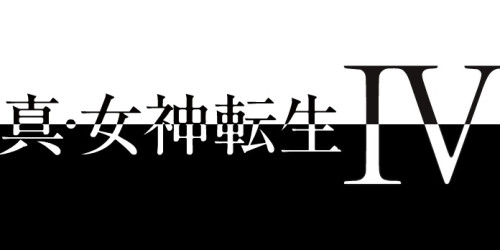
Shin Megami Tensei IV review
They say variety is the spice of life.
One can only spend so much time playing colorful platformers, multiplayer shooters, and adventure/puzzle games before one wants to try something new. I’m not about to experiment with mobile slop or online RTS any time soon. Maybe a military FPS. Maybe an open world Western action/RPG littered with bugs and DLC. Maybe a MOBA. Wait, no! You know what might be fun?
A Japanese role-playing game! I don’t mean family-friendly Nintendo fare like Pokemon, Paper Mario, Golden Sun, or Fire Emblem. I mean a gritty, dark, complex JRPG by the famous minds behind the Persona series. Full of adult language, murder, and questions raised about when mere men are given the power to control the outcome of the entire human world. Something so damn Japanese that they don’t even bother translating the title. That’s what I need in my life right now.
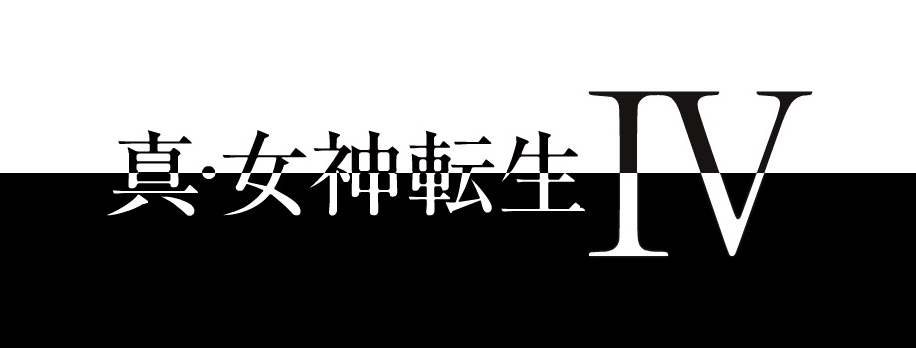
My history with Chinese tells me that those kanji mean “reincarnation of the true goddess”. Whatever that means.
SPOILER WARNING: This review contains copious spoilers for the detailed story of SMTIV.
Above was my mental process before jumping into Shin Megami Tensei IV, an RPG developed and published by Atlus on the Nintendo 3DS in 2013. To my confusion, I found that SMTIV is not any sort of sequel to any other Shin Megami Tensei title, leading me to wonder why it even has that name. Regardless, this straight-forward RPG with full English voice work spoken over an incredibly Japanese world is a sort of curiosity that I thought would be perfect to help explore this genre further.
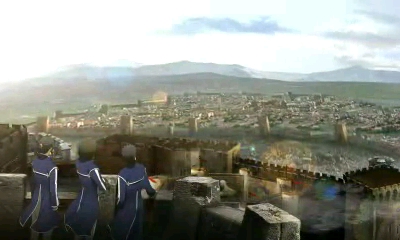 The story of Shin Megami Tensei IV begins in the realm of the Eastern Kingdom of Mikado, a rather knights-and-dragons European medieval setting that is home to our main characters, a small team of novice Samurai. The government of Mikado recruits Samurai to protect the kingdom contained with walled cities of Luxurors and Casualries (the former being the pompous aristocracy and the latter subjected to squalor and heavy labor).
The story of Shin Megami Tensei IV begins in the realm of the Eastern Kingdom of Mikado, a rather knights-and-dragons European medieval setting that is home to our main characters, a small team of novice Samurai. The government of Mikado recruits Samurai to protect the kingdom contained with walled cities of Luxurors and Casualries (the former being the pompous aristocracy and the latter subjected to squalor and heavy labor).
Our protagonist (default name: Flynn) comes from the Casualry class along with his friend Walter. Walter is an anime stock character with a brash and arrogant attitude. He just loves to talk back to anyone who even looks sideways at him, peer or authority. Our other comrade in Samurai training is Jonathan, a quiet and proper anime stock character who leads his actions with thoughts instead of feeling. Fourth in our party is Isabeau, yet another anime stock character who loves romance manga and criticizes the rude and frat-boy attitudes of the men around her.
If you have trouble navigating the travel menus in Mikado, don’t worry. It’s not you. They’re very unclear. Assuming the greenhorn Samurai find their way, the game wastes little time in sending these our heroes on incredibly dangerous missions to possessed forests and underground dungeons infested with invading demons. The main hook here is that the game starts off in this very familiar medieval fantasy setting, only to have the character travel through underground catacombs to eventually find themselves in post-apocalyptic Tokyo. This might have been a cool twist if it weren’t written on the game box.
En route, we encounter the first real stumbling block to Shin Megami Tensei IV. The difficulty curve. Starting off simple and becoming gradually more difficult as the campaign progresses is the basic schematic for just about any genre. The demons that you encounter below Mikado will propel you to about level eight or nine before you fight your first boss: the Minotaur.
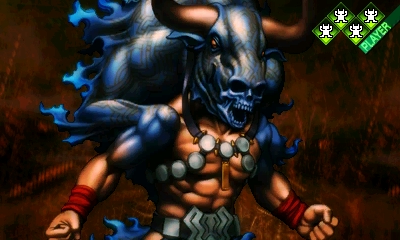
I hate you. I hate you. I hate you. I hate you. I hate you.
The Minotaur is (bafflingly) at level fourteen and is granted three actions per turn (more on the actual battle system in a little bit). The player’s party is so drastically under-powered in this battle that I have trouble believing that Atlus knowingly programmed such an unfair battle so early on. I found out upon multiple failures that after three deaths the game will unlock the Easy Mode. Only then was I able to put down the Minotaur as well as the equally over-powered Medusa who followed. All they’d have to do is adjust the numbers to fix this balance problem.
Upon reaching Tokyo, the difficulty finds its footing. Here the player is allowed to fully grasp the battle system at 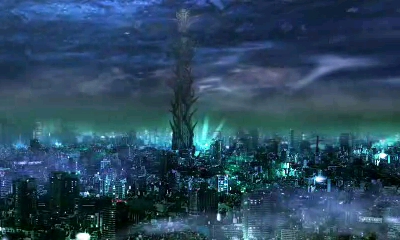 play. Your active party is composed of one protagonist Samurai and three demons from your repertoire. Demon allies are not gleaned through the story but through battle. Upon encountering a battle sequence, any demon that you are able to fight can be recruited by the player (except bosses). Through randomized dialogues and offering money, items, HP or magic power, almost any enemy can become your friend. You can engage in dialogues with enemy demons to heal you, give you money, or suggest quests. In Shin Megami Tensei IV, battles are not only EXP mines but opportunities to truly expand your power.
play. Your active party is composed of one protagonist Samurai and three demons from your repertoire. Demon allies are not gleaned through the story but through battle. Upon encountering a battle sequence, any demon that you are able to fight can be recruited by the player (except bosses). Through randomized dialogues and offering money, items, HP or magic power, almost any enemy can become your friend. You can engage in dialogues with enemy demons to heal you, give you money, or suggest quests. In Shin Megami Tensei IV, battles are not only EXP mines but opportunities to truly expand your power.
Once you’ve recruited an army of demons, the game kicks into gear. While exploring the ruins of Tokyo and researching its downfall, foes both devilish and mortal block your path. Every combatant has, like Pokémon, elemental alignments. Strike an enemy with their weak element to do massive damage as well as gain an extra turn. (Note: this applies to both your team as well as your foes.) Hit an enemy with their strong element to reflect that damage backward to you or to heal the attackee. It requires diligent attention to alignments and abilities to advance through all battles. Luckily, the HUD provides markers for how effective or ineffective an attack will be. Elements include Fire, Ice, Wind, Electricity, Gun, Light, Dark, and Physical. Fuse demons as often as you can to build a coterie of soldiers with ideal elemental abilities to take on any challenge.
Fill your ranks with the Jaki Grendel. Think you can win the favors of Bifrons? How about Gu Huo Niao? Do you think an Arahabaki is out of your league? Then perhaps an Ouroboros might be a better choice. Who would you send to the front lines against a Xi Wang Mu? A Lilim or an Asmodeus?
What gives an extra edge to this system is how non-structured it is. There are over four hundred deities available to the player. Most of them are not recruited, but fused by combining two demons together. You can then choose what physical attacks, magic spells, buffs and debuffs will carry over. As demons level up, random abilities will be available to them. This means that as you go on, there are countless possible ways that you can fuse your demons and build a legion of followers. No strict classes or jobs here. Any demon can learn any ability that you want from healing to offensive magic to stat boosts. No two players will ever have the same team.
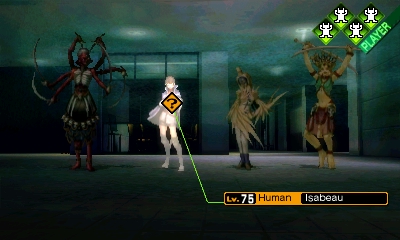
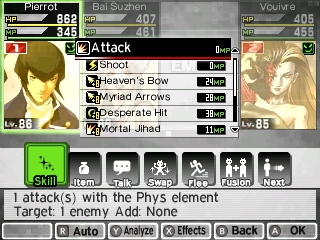
A mock-up of the two battle screens. Plus a spoiler.
Your demon pals even share their specialized skills with the player. The player, though, also can equip weapons and armor as you’d expect from this genre. The best way to level up and find better gear is to take on quests from the local seedy night clubs scattered around Tokyo. The quests are your typical fetching and hunting tasks. Luckily, the menu for organizing them is well put together. Questing here is engaging. Engaging in a very vapid, repetitive Skinner Box sort of way, but engaging enough for me to sink hours thoughtlessly.
The throes of tedious quests serve as a decent distraction from the direction that the story takes. Geez, I can hardly remember much of the details. There’s a group of humans in Tokyo called the Ashura-Kai who have found a way to manufacture pills that keep demons at bay. The Ashura-Kai control most of Tokyo with an iron fist, resisted only by some weird warrior folk called the Ring of Gaia. The Ring of Gaia wants to destroy the Ashura-Kai because, as you eventually find out, those red pills that demons love so much are filled with liquid from the brains of butchered people. This story is like cornbread. It’s all so predictable and plain. But it fills the empty space.
Later on we encounter the actual meat of Shin Megami Tensei IV: the moral divide. You see, throughout the entire game, bits of dialogue will ask you questions with two possible answers. In typical Atlus fashion, the sum of how you answered those questions will decide which of three endings the player will see. The three paths are that of Chaos, of Law, and Neutral. My playthrough ended up being Law.
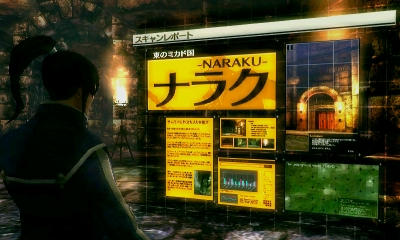 The binary morality here is like this: Do you believe in establishing some sort of higher order in the world to maintain fairness? Or do you believe in natural selection? That the strong should naturally hold power over the weak?
The binary morality here is like this: Do you believe in establishing some sort of higher order in the world to maintain fairness? Or do you believe in natural selection? That the strong should naturally hold power over the weak?
Those siding more with the first philosophy with follow Law. You will team up with Jonathan and the warriors of God to go down to hell to smite Lucifer. I am left to assume that those choosing the Chaos option will side with Walter, align with the forces of Hell to travel through the Pearly Gates and usurp I Am Who Am. There is also a Neutral Path. Along with Isabeau, you and her unite to defeat both Lucifer and God.
At first I wanted to criticize the writers for making the sole female voice dull as bricks while the male characters have these conflicting ideologies based on their backgrounds. However, I never really agreed with Walter’s arrogant attitude toward authority and general recklessness. I also found little common ground between me and Jonathan for his love for a system of order that has no concern for him at all. Why does he want to protect Mikado and destroy Tokyo anyway? What’s his motivation? Oddly, it’s the plain-as-paper, demure Isabeau with whom I felt some kinship. She mostly sits to the side and lets others argue. She doesn’t judge or force her opinion on others. I, too, wouldn’t pick sides between Heaven and Hell over the fate of the world. I’d also take that middle path. I’d let mankind decide for itself. Who am I to be some monarch? Some god? I’m only a man.
All in all, it’s a pretty interesting divide of philosophy. In a strange way, I learned something about myself today. I learned that there are 1) those who wish to see the world change in drastic ways so as to grant equality to all, 2) those who’d prefer to maintain the status quo as they’ve always known it, and 3) those who only wish to live their own lives and not extend their own morality onto the world. I think that I belong in the third category. Where do you think you’d end up?
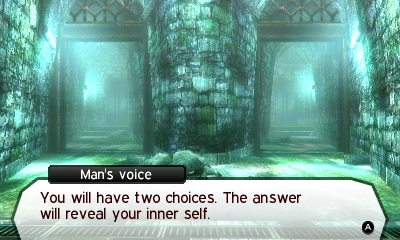
Your fellow players are here to assist you on your journey to vanquish to powers of God or Satan. Streetpass for Shin Megami Tensei IV allows Samurai to exchange one of their demons with others, automatically fusing them. It’s a nice, little incentive for players.
After over forty-five hours of demon slaying and quest-fulfilling, I have completed my first non-Nintendo JRPG (besides Final Fantasy III). All in all, despite a forgettable soundtrack and bland world design, I enjoyed myself. The drawings of the demons are hit or miss. The layout of Tokyo is dense and confounding for those who don’t live there in real life. I only spent twelve not-entirely-sober hours there, and that didn’t help me much. Stock characters serve their function as agents for the game’s black-and-white-and-gray philosophical fork.
Assuming you can get past those major difficulty bumps early on, a very clever and engaging RPG is what you’ll find in Shin Megami Tensei IV. The battle system blending friends with foes and limitless customization of one’s party prevent one from being bored by a standard quest world and lackluster plot points. Excellent English localization and a cast of hundreds of mythical creatures and demigods fill an all-star cast from religions of India and China and Ireland and Norway and Japan and Aztec Central America. Anyone willing to put time and money into Shin Megami Tensei IV will be rewarded.
4/5
Well Worth It
Categories: Reviews
0 Comments
This post has been left all alone with no comments. Don't leave it lonesome - give it some company with a comment.